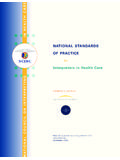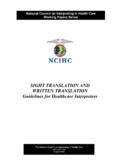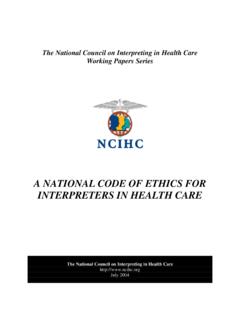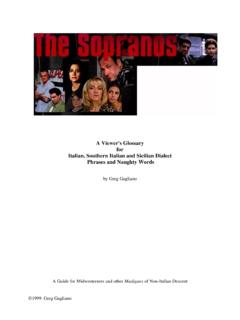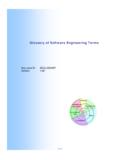Transcription of THE TERMINOLOGY OF HEALTH CARE …
1 The National Council on Interpreting in HEALTH care Working Papers Series THE TERMINOLOGY OF HEALTH care INTERPRETING A glossary of terms This Guide was produced under a contract between the Department of HEALTH and Human Services Office of Minority HEALTH and the National Council on Interpreting in HEALTH care (NCIHC). Copies are available from the NCIHC. The National Council on Interpreting in HEALTH care October 2001; revised and updated with Board approval August 2008. Introduction HEALTH care Interpreting is an emerging profession in the United States. This glossary defines commonly used terms from the language industry as they are used in the interpreting profession today. Terms and definitions were collected from many sources. The NCIHC gratefully acknowledges the contributions of those sources, particularly ASTM International.
2 The goal is to provide the end user of interpreting services and professionals in the field with the vocabulary necessary to engage in meaningful dialogue. It is our hope that such dialogue will contribute to the advancement of culturally competent professional HEALTH care interpreting and equal access to HEALTH care for individuals with limited English proficiency (LEP). Acknowledgements This glossary was compiled and written by the Standards, Training and Certification Committee of the National Council on Interpreting in HEALTH care , with input from some members of the Board. It was reviewed and approved by the Board of Directors in September glossary was revised and expanded by the Standards, Training and Certification Committee in 2007-08, and the present version was approved by the Board of Directors in August 2008.
3 Standards, Training and Certification Committee Shiva Bidar-Sielaff, MA, co-chair Karin Ruschke, MA, co-chair Maria-Paz Avery, PhD Bruce Downing, PhD Gregory Figaro Carola E. Green Linda Haffner Cindy Roat, MPH NCIHC Board of Directors Wilma Alvarado-Little, MA, co-chair of the Board Joy Connell, co-chair of the Board Barbara Rayes, Secretary Maria Michalczyk, RN, MA, Treasurer Niels Agger-Gupta, PhD, co-chair, Policy and Research Committee Enrica Ardemagni, PhD, co-chair, Organizational Development Committee Shiva Bidar-Sielaff, MA, co-chair, Standards, Training and Certification Committee Rashelle LeCaptain, co-chair, Outreach Committee Lisa Morris, co-chair, Organizational Development Committee Merlyn Perez, co-chair, Outreach Committee Jason Roberson, co-chair, Membership Committee Karin Ruschke, MA, co-chair, Standards, Training and Certification Committee Jorge Ungo, co-chair, Membership Committee Doreena Wong, JD, co-chair.
4 Policy and Research Committee glossary OF TERMS RELATED TO INTERPRETING IN HEALTH care A language a language in which the interpreter has native proficiency in speaking and listening [ASTM]. See B language. accreditation a term usually referring to the recognition of educational institutions or training programs as meeting and maintaining standards that then qualify its graduates for professional practice. See certified interpreter. ad hoc interpreter an untrained person who is called upon to interpret, such as a family member interpreting for her parents, a bilingual staff member pulled away from other duties to interpret, or a self-declared bilingual in a hospital waiting-room who volunteers to interpret. Also called a chance interpreter or lay interpreter. See certified interpreter, qualified interpreter.
5 Advocacy any action taken (by an interpreter) on behalf of an individual that goes beyond facilitating communication, with the intention of supporting good HEALTH outcomes. In general, advocacy means that a third party (in this case, the interpreter) speaks for or pleads the cause of another party, thereby departing from an impartial role. See transparency. advocate a person who acts to further the interests of another party. When taking an advocacy role, the interpreter may speak in their own voice in order to plead a cause or attempt to right a wrong B language a language in which the interpreter has full functional proficiency in speaking and listening [ASTM]. See A language. back translation translation of translated document back into the original language.
6 Often used to check the accuracy of the original translation, although professional translators do not use this process to check the accuracy of a translation. bi-directional interpreting interpreting between two languages where each functions as both a source and target language bilingual a term describing a person who has some degree of proficiency in two languages. A high level of bilingualism is the most basic of the qualifications of a competent interpreter but by itself does not insure the ability to interpret. bilingual provider a person with proficiency in more than one language, enabling the person to provide services directly to limited-English-proficient patients in their non-English language bilingual worker / employee an employee who is a proficient speaker of two languages and may provide direct services in both languages, but who without additional training is not qualified to serve as an interpreter certificate a document, such as a certificate of attendance or completion, that attests to participation in a course of study and attainment of some The TERMINOLOGY of HEALTH care Interpreting revised August 2008 3learning objective.
7 A person who holds a certificate related to interpreter training is not thereby certified. See certification, certified interpreter. certification a process by which a certifying body (usually a governmental or professional organization) attests to or certifies that an individual is qualified to provide a particular service. Certification calls for formal assessment, using an instrument that has been tested for validity and reliability, so that the certifying body can be confident that the individuals it certifies have the qualifications needed to do the job. See certified interpreter. certified interpreter an interpreter who is certified as competent by a professional organization or government entity through rigorous testing based on appropriate and consistent criteria.
8 Interpreters who have had limited training or have taken a screening test administered by an employing HEALTH , interpreter or referral agency are not considered certified. See ad hoc interpreter; qualified interpreter. community interpreting interpreting that takes place in the course of communication in the local community among speakers of different languages. The community interpreter may or may not be a trained interpreter. Community settings include schools, social service agencies, clinics, legal services, and businesses that serve a diverse clientele. See qualified interpreter. consecutive interpreting the conversion of a speaker or signer s message into another language after the speaker or signer pauses, in a specific social context [ASTM]. See simultaneous interpreting.
9 Cultural and linguistic competence a set of congruent behaviors, attitudes, and policies that come together in a system, agency, or among professionals that enables effective work in cross-cultural situations. 'Culture' refers to integrated patterns of human behavior that include the language, thoughts, communications, actions, customs, beliefs, values, and institutions of racial, ethnic, religious, or social groups. 'Competence' implies having the capacity to function effectively as an individual and an organization within the context of the cultural beliefs, behaviors, and needs presented by consumers and their communities. (CLAS Standards, adapted from Cross, 1989) cultural broker(ing) any action taken by the interpreter that provides cultural information in addition to linguistic interpretation of the message given.
10 See transparency. cultural consultant a person with the ability and experience to conduct training for HEALTH care providers on how to provide culturally sensitive care to their ethnically diverse patient population dual-role interpreter a bilingual employee in HEALTH care who has been tested for language skills, trained as a medical interpreter and assumes the task of part-time medical interpreting willingly. See ad hoc interpreter. The TERMINOLOGY of HEALTH care Interpreting revised August 2008 4face-to-face interpreting interpreting in which the interpreter is present in person with both, or at least one, of the persons for whom interpreting is provided. See remote interpreting, telephonic interpreting. first-person interpreting the promotion by the interpreter of direct communication between the principal parties in the interaction through the use of direct utterances of each of the speakers, as though the interpreter were the voice of the person speaking, albeit in the language of the listener.
